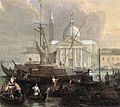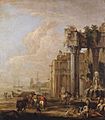Luca Carlevarijs facts for kids
Quick facts for kids
Luca Carlevarijs
|
|
|---|---|

Portrait (1724) by Bartolomeo Nazari
|
|
| Born |
Luca Carlevaris
20 January 1663 |
| Died | 12 February 1730 (aged 67) |
| Nationality | Venetian |
| Known for | Landscape art |
Luca Carlevarijs (born January 20, 1663 – died February 12, 1730) was an Italian painter and engraver. He worked mostly in the beautiful city of Venice. He was a very important artist because he helped start a new style of painting. This style was called vedute (say: veh-DOO-tay), which means detailed paintings of city scenes. His work focused on Venice, and later, famous artists like Canaletto and Francesco Guardi followed his lead.
Contents
Luca Carlevarijs: Life and Art
Luca Carlevarijs was born in a town called Udine. People sometimes knew him by other names, like 'Luca Casanobrio'. This was because important families, like the Zenobri family, supported his art. He spent most of his life and career in Venice, where he also passed away.
His Family and Influences
Luca's daughter, Marianna Carlevarijs (1703 - 1750), also became an artist. She learned how to create amazing pastel portraits. Luca himself visited Rome, a very old and artistic city. There, he was inspired by a Dutch painter named Caspar van Wittel. Van Wittel was known for his detailed city views of Rome.
Painting Venice's Beauty
After his trip, Luca Carlevarijs began to paint vedute of Venice. These were some of the first detailed paintings of the city from the Baroque art period. He painted many different types of scenes. These included landscapes, sea views, and detailed cityscapes. Some of his works even showed imaginary places with old ruins.
He also created more than one hundred etchings of Venice. Etchings are a type of printmaking. These prints showed exact pictures of the main places in the city.
Inspiring Other Artists
Many famous painters, like Canaletto, Francesco Guardi, and Antonio Visentini, were influenced by Luca's work. Some people even say they were his students. Luca's paintings and his collection of 104 etched views of Venice, published in 1703, were a big inspiration for Canaletto and Guardi.
Luca also worked with other artists. For example, Johan Richter collaborated with him. He also teamed up with painters who specialized in adding people (called "staffage") to his landscapes and city scenes.
Gallery
-
Doge's Palace and Riva degli Schiavoni
-
Piazzetta and Library
See also
 In Spanish: Luca Carlevarijs para niños
In Spanish: Luca Carlevarijs para niños




















